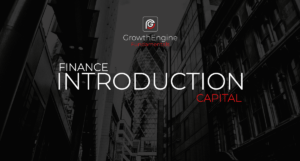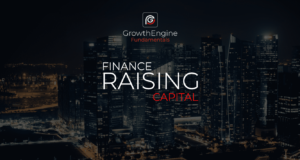
Finance Fundamentals – Managing Capital
Introduction
So once we’ve employed the capital into the business, how do we best manage it?
So I’ll just go back there.
How do we best manage capital because if you just sort of pour it into the area, and are not managing it, that’s not going to get the best return?
Often one of the biggest frustrations from an investor point of view, one of the biggest frustrations from you as a business owner is when you look back and think how we wasted that money or we didn’t best use it.
Then you’ve got to go back to the bank, sort your B, C, your venture calculation, your angel and say look we did, we got this wrong.
Can we have some more money?
That becomes either more expensive.
They may not even fund you at all.
They may think you’re irresponsible, and once you will make mistakes and it’s acceptable that you make mistakes.
Then what we’re trying to do is say hey, you wouldn’t, if you got a heart condition you’re going to put a heart monitor on there.
You ‘re going to monitor that, the beats and things like that.
So capital is a resource that isn’t replaceable.
It’s not like energy a time that’s lost but it can be replaced but it can be very very costly, especially if you have to give more equity away or give more security to borrow more capital.
So, here’s a couple of overview areas that I would recommend that you have a firm handle on and there are no major surprises but you do need as you would with your;
- Business Model Strategy
- Your Sales
- Marketing Strategy
- Your People
- Recruitment Strategy
- Your Production Regulations
- Strategy
- Accounting Strategy and a Financial Infrastructure to measure that
Systems
With a government making tax digital and the low cost of running accounting systems these days, you don’t have to.
I mean, unless you’re a seriously large business, most small and growth-focused businesses can run off things like Xero or Intuit, QuickBooks, smaller packages on Sage although I recommend Xero and QuickBooks.
I think they’re certainly a fabulous tool at low cost.
So you’re going to need some type of financial infrastructure system and somebody who can tell you to run that or you can outsource that to a bookkeeper or your accountant.
But when managing capital what we’re really looking for, looking at is it’s not just the cash that we’re looking at.
It’s assets.
Something that will depreciate.
Whether that’s a straight line or there’s a percentage per annum.
Also managing liabilities because the balance sheet that we’re going to talk about in a few minutes, one side is assets, one side is liabilities and capital.
If you’ve got the money that’s required to repay those liabilities especially if it’s a loan or something of that basis, it’s having to keep an eye on both the assets and the liabilities to manage capital to make sure that they’d be explored.
Are we investing the right amount of money into the assets and are we using the right investment vehicle, acquisition vehicle?
- Is it a cash purchase?
- Is it a lease?
- Is it on or off balance sheets?
- Is it shorter than a rental or are we just going to pay and buy it outright?
So that’s what, think about what’s the best use for assets and again so many different permutations around that and your accountants or your auditor would be a great way for your non-executives to have a chat around that.
Then liabilities of course.
Making sure that we can spread the right area.
Meet the requirements so it’s not turning into the cash flow too high and things like that.
So, managing capital in working capital.
Ultimately the business is moving, it’s an ever-changing, it’s a dynamic business.
The phone rings, that’s a different conversation to the last one.
Invoices are being struck and raised and issued out and then there’s a timing before the cash comes into the bank and even if you’re an eCommerce business where you get paid up front, you’ve still got to delay before the cash hits the bank.
Because whether you’re using Stripe or Worldpay or Authorized.net or any of these eCommerce sites, it could be three days, it could be five days.
Standard Stripe account is seven days before it hits your bank.
So you’re going to need working capital to pay all the bills, keep the lights on and again whether that’s managing an overdraft facility, managing the repayment of a loan, and or just cash reserves if you’re fortunate enough to have cash reserves, then keeping that there so you’re not burning through that and that sort of segways and goes into the cash flow liquidity.
Cash Reserves
At any one period of time, you’ll see at the bottom of the screen we talk about cash flow statements and that’s really assessing any given period of time.
Ultimately the cash flow liquidity.
Do we have enough cash to pay the immediate liabilities before the next cash comes in, whether that’s an invoice for payment from a client or such?
We talked earlier under the liability section about debt repayment.
Often bad management can result in cash coming in and you not having the right payment structure throughout the month and I always recommend even if you’d set up like a Google sheet or an Excel spreadsheet and just put one to 31 across the bottom and then just put when all your money goes out of the bank.
- Your direct debits
- Your rent
- Your telephone bill
- Your salary, any major back payments for suppliers that you have to pay.
Load those in and then when you are looking at it and you can see where the cash peaks and troughs are going to be throughout the month and then if that’s a loan repayment like debt repayment, then ultimately you can make sure there’s enough there.
Often I see when I work with businesses that they don’t get the time and then the loan repayment to get the money and if they’ve invested it especially a few months down the line, when they’re relying on their creditors as paying them on time and the debtors and the creditors all that type of inflow and outflow of money whereas sometimes the loan repayment bounces just for a day because there wasn’t enough cash in the bank or it breached the overdraft.
That can send shock waves through the loan provider and it can be avoided just by managing capital and the inflow and the outflow.
And savings.
Just because you’ve got a cash reserve it doesn’t mean you willy-nilly go and buy everything.
I see it all so often where entrepreneurs and growth-focused people they have like 20 grand in the bank.
Oh I’ll buy that new car or I’ll buy that new office or equipment and furniture or whatever, and really cash in the bank is not always a reflective or an accurate reflection of how the business is trading.
So managing savings, it’s pretty important and ultimately sometimes if you either as you bank with a high street bank;
- HSBC
- Barclays
- Santander
- Lloyd’s
- NatWest
Whatever it would be, sometimes it’s better to pull that cash reserve out and put it into a different savings company if you can sign it up for three months, six months, nine months, 12 months.
Sometimes there are external savings companies who will give you immediate notice that will pay a higher rate of interest.
So, managing capital and the positive cash balance is a great way to make a little bit of extra money and make your money work harder.
Profit And Loss
So, once you’ve managed your capital, it’s really going to drop into your profit and loss.
Which is ultimately by any given period that day, that week, that month, that quarter or that year.
How is your business trading?
How much income versus direct costs, COGS, costs of goods sold, the cost of goods bought in to facilitate that.
To give me the gross margin to then look at your over reds or your indirect costs should I say, to then see if you’ve made a profit, a net profit at the bottom.
So profit and loss, that’s a great way and I recommend that if you are running something like;
- Xero
- Intuit
- Sage
- QuickBooks
Those type of products, it’s not difficult.
If you can’t do it yourself, ask your bookkeeper or your accountant just to set up a monthly PNL and then you can log on, look at the dashboard.
It could be daily, weekly, monthly and it’s going to give you a real good solid sense of how your business is performing in real time.
The balance sheet, ultimately the book value or the net asset value of your business with all your assets, less your liabilities plus any cash.
What’s it worth today and sorry apologies, not cash.
Equity at the bottom.
So, what are your assets minus your liabilities plus any equity?
That’s going to give you the balance sheet.
What is the book value of your business?
Then cash flow.
I talked about that earlier when we were mentioning about working capital and cash flow liquidity.
It’s really any period of time, in the next seven days how much cash do we need to pay the bills and keep the lights on and what’s the forecast going to look like how much cash are we going to even need to keep the lights on all the cash flow statement?
How much money are we going to make or lose?
So these are some areas that you should have.
I would have firm handles on your cash flow statement on an ongoing basis.
Your balance sheet is, it isn’t a year-end, it can be a year-end but monthly and quarterly just to make sure you solvency and how you trade him.
Any profits or losses that you’re making is going to get transferred into your balance sheet to either increase or decrease that but, get some angles on these, get some firm grips on these and start to learn to manage your capital a lot better.
So if you’ve got any questions on managing capital, again I’d be delighted to answer some questions for you on that.

There’s no sales pitch from us.
One of our Growth Engine inbound pro’s is going to sit down and they’re really looking at three things.
Where you’re at as a business, they’re going to learn about your business, they’re going to see if we’re really a good fit and you’ve got problems or challenges or pain points or aspirations that we can help with.
The worst thing if you come off the call, you’ll have had some free solid tips.
And then if that’s something that works well we can set up some further 45-minute sort of what we call discovery calls and meetings to really dig deep with that.
And if you want to take advantage of that, literally click the let’s talk button on this page, or you can head over to any page on https://mikejmidgley.com/ for everything.
Including details about Growth Engines and what we do from there. So that wraps up our Growth Engine Fundamentals on Introduction to Finance.
As I say to wrap, if you want to shoot over to Twitter and use #AskTheAgency or #GrowthEngine ask us any questions.
We’ll get those answered for you.
Alternatively, leave us a comment below on the blog.
If you’re watching this on the YouTube channel and want to know what the blog address is, it’s https://mikejmidgley.com/
So that’s https://mikejmidgley.com/
You can head over there and as always to Get In The Game, Go Do The Hustle, Go Make It Happen and we’ll catch up with you on a Growth Engine Fundamental real soon.
If you’d like to check out the rest of the Growth Engine finance fundamentals series, select an article below









